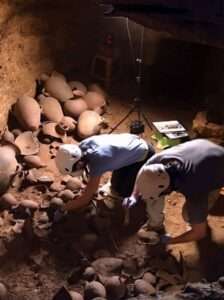French-Lebanese archaeologists uncovered a vast underground necropolis dating back 3,800 years in the millennial city of Byblos. This significant find is considered the most important discovery in a century, surpassing all prior excavation campaigns of the 19th and 20th centuries. The discovery includes eight untouched hypogea, serving as the final resting place for individuals from the Middle Bronze Age who have been undisturbed for thousands of years.
This remarkable archaeological find sheds new light on the ancient history of Byblos and the burial practices of its ancient inhabitants. The untouched hypogea provide valuable insights into the funerary customs and beliefs of the Middle Bronze Age civilization that once thrived in the region.

The discovery of the necropolis represents a breakthrough in archaeological research, offering a rare glimpse into a period of history that had previously remained shrouded in mystery. By carefully excavating and studying the burial sites, archaeologists hope to uncover more details about the lives and traditions of the people who inhabited Byblos thousands of years ago.
The find has sparked excitement and renewed interest in the study of ancient civilizations, with experts from around the world eager to learn more about this important archaeological site. The meticulous work of the French-Lebanese team has been praised for its attention to detail and dedication to preserving the integrity of the burial sites.
As researchers continue to analyze the artifacts and human remains found in the necropolis, it is expected that new revelations about the history and culture of Byblos will come to light. The discovery of this ancient burial site underscores the importance of ongoing archaeological exploration in uncovering the secrets of the past and preserving our shared heritage for future generations to appreciate.
In conclusion, the unveiling of the underground necropolis in Byblos is a momentous discovery that has the potential to reshape our understanding of the ancient world. Through meticulous excavation and analysis, archaeologists are piecing together the puzzle of the past, unraveling the mysteries of a bygone civilization that has long captivated the imagination of historians and archaeologists alike.





